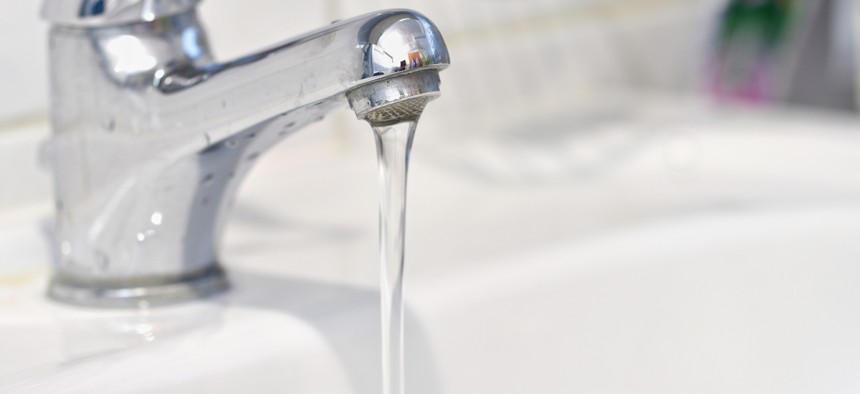As More Americans Struggle to Pay Water Bills, Affordability Solutions Are Past Due

People of color and low-income families are at higher risk of water shut-offs. SHUTTERSTOCK
COMMENTARY | With utility shutoff moratoriums expiring, millions of people, particularly people of color and low-income families, are at risk of losing water service.
When Covid-19 brought many parts of our economy to a grinding halt last spring, millions of Americans were thrust into unexpected financial peril. By April, all 50 states and the District of Columbia had unemployment rates that exceeded those of the 2008 economic crisis. Many households were faced with insurmountable debt, food insecurity and imminent utility shutoffs.
In response, multiple state and local governments—though not all—issued emergency moratoriums to prevent providers from shutting off power and water services due to nonpayment. Almost a year later, the novel coronavirus is alive and well, yet most moratoriums have either expired or are about to. Once again, shutoffs loom—with one-third of utility customers in states like Wisconsin behind on their bills.
An Unfair Shake
Although Covid-19 threw the issue of water affordability into sharp relief, it’s not new. Facing mounting expenses related to replacing infrastructure, updating plants and responding to extreme weather events, utility providers have been forced to raise prices over the past decade. In fact, an analysis of a dozen U.S. cities by The Guardian and Consumer Reports showed the cost of water and sewage increased by about 80% from 2010 to 2018.
Unsurprisingly, low-income families are paying an outsized portion of their income for necessities like utilities. Across the United States, water bills were considered nearly universally unaffordable for the most disadvantaged in 2018. And in 11 of the 12 cities analyzed, 100% of the population with incomes below 50% of the federal poverty level lived in communities with unaffordable water.
Research also confirms that people of color are disproportionately affected by shutoffs. Even before the pandemic, Black families earning less than 1.5 times the federal poverty level were twice as likely as white families to experience shutoffs. And a 2018 study determined that two-thirds of Latino utility customers in California lived in ZIP codes with the highest shutoff rates.
In Detroit, where almost 80% of residents are Black, city officials in 2014 launched an extensive shutoff program that has disconnected almost 150,000 households since it began. The United Nations has since condemned the program as a human-rights violation that disproportionately affects Black people.
The pandemic only intensified preexisting water inequity. In a 2020 survey of low-income American households, Black respondents were twice as likely to say that they could not pay their energy bills in April or May.
Finding Future-Focused Solutions
To begin tackling this problem, we must first paint a clearer picture of residents’ needs through enhanced data collection. During the height of Covid-19 lockdowns, we saw nonresidential water usage plummet and residential usage surge because everyone was trapped at home. What kind of account balances were people building up during that time? And as unemployment mounted, at what point did people start falling behind on their bills—and by how much?
We need greater data transparency in order to answer these questions, yet providers aren’t required to disclose this information. Governing bodies and utility commissions would be wise to require more thorough utility tracking and data reporting on overdue bills, shutoffs and repayment plans. And yes, it is possible to do this without compromising citizens’ privacy.
Once we have a better idea of the need, we can begin to propose solutions to the problems with water affordability. It’s important to clarify that water should not be free. In fact, part of the reason utilities cannot improve infrastructure is that water is so undervalued and underfunded. Someone needs to pay for it, but the burden shouldn’t fall heaviest on low-income households.
States and localities drive over 95% of public spending on water infrastructure annually, so it follows that discussions around waterworks spending and the affordability of service often begin and end at the local level. But federal officials also have a role to play and should provide more coordinated and regional-focused water financing policy direction and increased financial support. States and municipalities petitioning the federal government for assistance is a good start—particularly for customer assistance programs. Those programs promise to help bolster providers’ financial capacity as they expand their affordability efforts.
Water access is a fundamental human right. Such an assertion may not seem radical—until we consider that even before the pandemic and resulting economic crisis, about one-third of U.S. households were already at risk of finding their water bills unaffordable by 2022, putting them at risk of shutoffs. It’s time to enact long-term solutions that protect our most vulnerable citizens and ensure that no one has to choose between food and clean running water.
Chris Shaffner is the senior vice president of the Water and Community Facilities division at CoBank, a national cooperative bank serving vital industries across rural America by providing loans, leases, export financing and other financial services in all 50 states.
NEXT STORY: 4 components of a digitally resilient government





